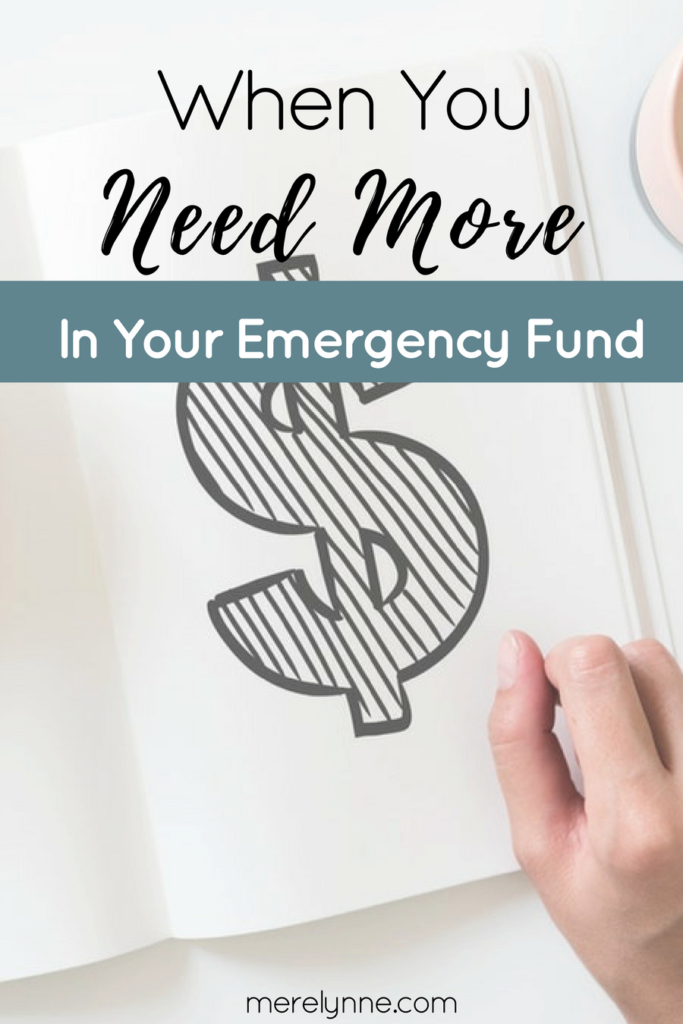
How much do you have in your emergency fund right now, in this very moment? Is it the recommended $1,000, more, or less? Or are you over here shaking your head going “what’s an emergency fund?”
Well if you’re the later one, then I recommend checking out my post from a few years ago that shared why were were so glad to have an emergency fund built up. Now if you’re someone that has the bare minimum of $1,000 or less in your emergency fund then you might want to consider bumping that amount up.
Now let me start off by saying $1,000 is a great starting point for any emergency fund. Plus, it’s no easy feat to reach that milestone. Especially when you have bills, sick kiddos, and life going on. Because without fail when you finally get there, you will always have something come up – need new tires, your fridge goes out, someone get sick, etc. So when you reach the $1,000 mark and keep it for a few months then you start to feel pretty darn proud of yourself.
So congratulate yourself on that milestone, because it’s huge!
Now if it’s so hard to reach $1,000 in your emergency fund then why am I suggesting you increase it? It’s simple – insurance deductibles.
Right now, today if you got into an accident how much would you have to pay your insurance? $500, $1,000 or more? What if both you and your spouse gets into separate accidents close to the same time period? Now you’re paying double the deductible.
For us, having more in our emergency fund came in handy when our son was born. He was sent to the NICU, so our medical bills were outrageous! We planned to be better financially prepared for our baby and one of the first steps was bulking up our emergency fund.
How can you quickly increase your emergency fund savings?
Well for us, the quickest way was to stop eating out – we even did a no eating out challenge for a few weeks. Think about it on average, your family might be spending anywhere from $20-50 a week on eating out. If you stop for 6 months or at least cut back to only spending $50 a month then you could add $1,000 to your fund.
You could also go through your home to find items you no longer use and sell them. Facebook Swap Shops are popping up everywhere or you can utilize Craigslist to find a buyer for your stuff. We’ve sold movies, clothes, purses, toys, and so much on Swap Shops. That money almost always goes straight to our savings account.
If you need more than $1,000, how much should you have?
This is a tough question to answer because every family is different. I recommend having at least enough to cover the $1,000 minimum plus one person’s health insurance deductible and enough for one auto deductible. So for our family that would be $3,000 in our emergency fund. You might be more or less depending on your insurance deductibles.
If you’re pregnant or planning on expanding your family then you might want to include the family deductible instead of the individual. If you have a teenage driver then you might want to include their auto deductible too.
Now, if you’re someone that doesn’t have the $1,000 in your account then that should be your first focus. Save your $1,000 then make sure you can keep it for a few months before starting to grow it. If you have debt and are focused on paying that off, then you need to find other ways to increase your emergency fund balance – that’s why I mentioned the no eating out challenge and selling old items around the house. You shouldn’t take away from your debt snowball, unless you’ve below the $1,000 minimum.
Need more help to build your emergency fund?
Have you seen the new CFO Bundle? If you’re needing a little more guidance or are wanting to keep on track with your spending, then check it out. It’s the perfect addition to your monthly budgeting routine. It can help you stay on track with your spending, know how much you’re spending and where. I’ve even included my favorite sinking funds spreadsheet to help you know how much to be saving each month to reach your financial goals. Check it out over in the shop HERE.
Latest posts by Meredith Rines, MBA, CFP® (see all)
- How To 10X Your Productivity With This Simple Tool // Using A Red Line Graph - June 24, 2020
- Mini DIY Office Makeover [Photowall Review] - June 17, 2020
- How To Track Your Projects and Profit With Subcontractors - June 11, 2020




